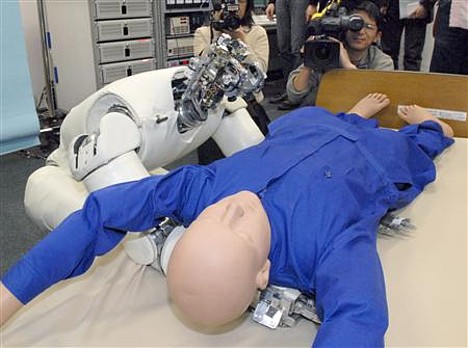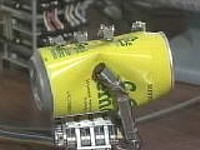 On March 22, a group of Japanese scientists released details of an ambitious proposal calling for the large-scale production of bioethanol made from cultivated seaweed.
On March 22, a group of Japanese scientists released details of an ambitious proposal calling for the large-scale production of bioethanol made from cultivated seaweed.
Researchers from Tokyo University of Marine Science and Technology, Mitsubishi Research Institute, Mitsubishi Heavy Industries and several other private-sector firms envision a 10,000 square kilometer (3,860 square mile) seaweed farm at Yamatotai, a shallow fishing area in the middle of the Sea of Japan. They claim a farm of this scale could produce about 20 million kiloliters (5.3 billion gallons) of bioethanol per year, which is equivalent to one-third the 60 million kiloliters (16 billion gallons) of gasoline that Japan consumes each year.
Seaweed has long been discussed as a potential source of bioethanol, which is typically made from crops such as sugar cane and corn, but the idea has never been brought to fruition. According to the proposal, giant nets used in nori and wakame seaweed cultivation would be laid out to cultivate sargasso seaweed (hondawara), which grows rapidly. Floating bioreactors -- special facilities that use enzymes to break the seaweed down into sugars -- would prepare the seaweed for conversion into ethanol, which would also be done at sea. Tankers would then transport the ethanol to land.
The main components of seaweed are fucoidan and alginic acid. While an enzyme for breaking down fucoidan has already been discovered, the scientists are looking for an enzyme that breaks down alginic acid. They are also looking at the possibility of using genetic modification technology.
The group is also conducting research on how to develop the production plants and attract investment. Other participants in the project include NEC Toshiba Space Systems, Mitsubishi Electric, IHI, Sumitomo Electric Industries, Shimizu Corporation, Toa Corporation, Kanto Natural Gas Development Co., Ltd., and the Japan Agency for Marine-Earth Science and Technology (JAMSTEC).
The researchers claim that in addition to serving as a source of fuel, the seaweed would help clean up the Sea of Japan. According to Professor Masahiro Notoya from Tokyo University of Marine Science and Technology, the seaweed would work to remove some of the excess nutrient salts that flow into the sea from the surrounding land masses.
Professor Notoya will formally present the proposal at the International Seaweed Symposium, which is set to begin on March 26 in Kobe, Japan.
[Source: Fuji Sankei]
 Bandai and Ginza Tanaka have teamed up to create a Mobile Suit Gundam made from pure platinum. Called Gundam Fix Platinum, the 12.5-cm (5-in.) tall, 1.4-kg (3-lb.) work features 89 separate parts and a head adorned with a 0.15 carat diamond. Hajime Katoki, a mechanical designer and illustrator noted for his work in a range of anime and games, oversaw the two-year long production process.
Bandai and Ginza Tanaka have teamed up to create a Mobile Suit Gundam made from pure platinum. Called Gundam Fix Platinum, the 12.5-cm (5-in.) tall, 1.4-kg (3-lb.) work features 89 separate parts and a head adorned with a 0.15 carat diamond. Hajime Katoki, a mechanical designer and illustrator noted for his work in a range of anime and games, oversaw the two-year long production process. 


 Since then, he has compiled a number of variations, some of which are featured on the
Since then, he has compiled a number of variations, some of which are featured on the  Fuji Sabo Works, an organization established by Japan's Ministry of Land, Infrastructure and Transport (MLIT) to fight erosion on Mt. Fuji, has released video of a powerful slush avalanche that occurred on Fuji's western side at 8:09 AM on March 25.
Fuji Sabo Works, an organization established by Japan's Ministry of Land, Infrastructure and Transport (MLIT) to fight erosion on Mt. Fuji, has released video of a powerful slush avalanche that occurred on Fuji's western side at 8:09 AM on March 25.  On March 22, a group of Japanese scientists released details of an ambitious proposal calling for the large-scale production of bioethanol made from cultivated seaweed.
On March 22, a group of Japanese scientists released details of an ambitious proposal calling for the large-scale production of bioethanol made from cultivated seaweed. A team of researchers from the Tokyo Institute of Technology (TIT) claim to have developed the world's first electromechanical prosthetic hand with a grip strong enough to crush an empty beverage can.
A team of researchers from the Tokyo Institute of Technology (TIT) claim to have developed the world's first electromechanical prosthetic hand with a grip strong enough to crush an empty beverage can. Mospeng-kun is a tissue-dispensing robot created by
Mospeng-kun is a tissue-dispensing robot created by  Researchers from Hokkaido University have created artificial blood vessels using collagen derived from the skin of salmon. The researchers, who replaced the aortas of rats with the artificial blood vessels, claim to be the first to create and successfully test artificial blood vessels made using collagen derived from marine animals.
Researchers from Hokkaido University have created artificial blood vessels using collagen derived from the skin of salmon. The researchers, who replaced the aortas of rats with the artificial blood vessels, claim to be the first to create and successfully test artificial blood vessels made using collagen derived from marine animals.